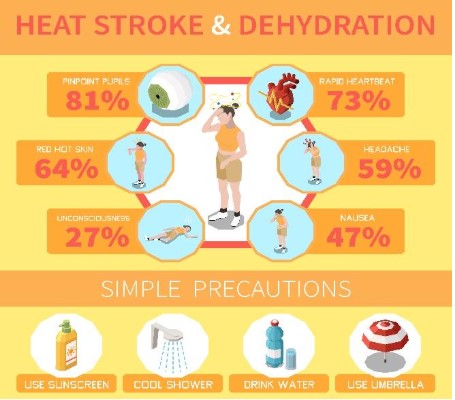SEO Keywords: heat stress, workplace safety, HSE, heat-related illness, occupational health, summer safety
When temperatures soar, so do the risks for workers especially those who work outdoors or in high-temperature environments like kitchens, factories, or construction sites. Heat stress is more than just discomfort. It can quickly turn into a medical emergency if not managed correctly.
What is Heat Stress?
Heat stress occurs when the body cannot cool itself down through sweating. This can lead to heat-related illnesses such as:
- Heat rash – irritating skin condition from excessive sweating
- Heat cramps – painful muscle spasms due to loss of salt and water
- Heat exhaustion – dizziness, nausea, and rapid heartbeat
- Heat stroke – a life-threatening emergency where the body’s temperature rises above 104°F (40°C)
Who Is at Risk?
- Outdoor workers (construction, agriculture, landscaping)
- Indoor workers in poorly ventilated or hot spaces
- Workers wearing heavy PPE (personal protective equipment)
- New employees not yet acclimatized to the heat
Prevention: Key HSE Practices
- Hydration is Critical
Encourage drinking water every 15–20 minutes—even if not thirsty. - Schedule Smart
Plan heavy work for cooler parts of the day (early morning or evening). - Dress for the Weather
Wear light-colored, loose-fitting, breathable clothing. - Train & Educate
Workers and supervisors should recognize signs of heat-related illness. - Use the Buddy System
Always monitor co-workers for signs of distress. - Provide Cool Rest Areas
Breaks in shaded or air-conditioned areas can save lives.
What Employers Must Do (According to HSE Guidelines)
- Conduct a heat risk assessment
- Implement control measures (shade, fans, rotation of tasks)
- Provide PPE like cooling vests where needed
- Maintain incident logs and follow up after any heat-related issue
Heat stress is preventable, yet it continues to cause injuries and fatalities globally.

Blog 2: Building a Heat Stress Prevention Program: Protecting Workers from Extreme Heat
SEO Keywords: heat stress prevention, workplace safety program, HSE compliance, summer work safety, occupational heat illness
As global temperatures rise, heat stress is becoming a major occupational hazard. Whether your team works outdoors or in hot indoor environments, developing a formal Heat Stress Prevention Program is now a necessity not a luxury.
Why Have a Heat Stress Program?
Every year, thousands of workers suffer from heat exhaustion or heat stroke, especially in industries like construction, manufacturing, agriculture, and logistics.
Employers are legally and morally responsible for providing a safe workplace. A well-planned program helps prevent costly incidents and promotes a safety-first culture.
Key Elements of a Heat Stress Prevention Program
- Risk Assessment
Identify jobs and work areas with high heat exposure. Measure temperature, humidity, radiant heat, and workload. - Acclimatization Plans
Gradually introduce new or returning workers to hot environments over 7–14 days. Sudden exposure increases risk of illness. - Hydration Strategy
Ensure water is available near work zones. Workers should drink 1 cup every 15–20 minutes. Avoid caffeine or energy drinks. - Training & Awareness
Conduct sessions on signs of heat-related illness, first aid response, and when to stop work. - Work-Rest Scheduling
Use heat index levels to plan work intensity. Include shaded or cooled rest areas. - Emergency Procedures
Train teams on what to do if someone shows symptoms. Quick cooling and calling emergency services can save lives.
Useful Tools and PPE
- Cooling towels or vests
- Light, breathable uniforms
- Portable misting fans or air movers
- Digital thermometers and heat index charts
Leadership Commitment is Key
Supervisors and HSE officers must lead by example. Encourage open communication, support rest breaks, and never ignore early signs of fatigue or overheating
Blog 3: Recognizing and Responding to Heat Stroke in the Workplace
SEO Keywords: heat stroke symptoms, workplace first aid, heat-related illness, HSE emergency response, occupational health
Heat stroke is the most dangerous form of heat stress and it can be fatal if not treated quickly. As temperatures rise, employers and workers must stay alert to early warning signs. Knowing what to do in the first few minutes can save lives.

What is Heat Stroke?
Heat stroke happens when the body’s temperature rises above 104°F (40°C) and can no longer regulate itself. This leads to the failure of the brain and internal organs. It often follows untreated heat exhaustion.
Key Symptoms to Watch For:
- Confusion or slurred speech
- Loss of consciousness (fainting)
- Hot, dry skin (no sweating despite the heat)
- Rapid pulse and breathing
- Seizures or convulsions
- Nausea or vomiting
Emergency First Aid Steps
- Call Emergency Services Immediately (e.g., 112 or 911)
Time is critical. Inform them of the heat stroke symptoms. - Move the Person to a Cooler Area
Preferably an air-conditioned room or shaded place. - Cool the Body FAST
Use cold, wet cloths, fans, or ice packs on the neck, armpits, and groin. - Do NOT Force Fluids
If the person is unconscious or confused, don’t try to make them drink. - Monitor Vital Signs
Stay with the person and check for breathing or signs of shock.
Prevention is Still the Best Response
- Train workers and supervisors to recognize heat stroke symptoms.
- Use buddy systems during hot tasks.
- Encourage hydration and scheduled cooling breaks.
- Rotate jobs in hot environments to prevent overheating.
Blog 4: Heat Stress Risks in Construction: What Every Site Supervisor Must Know
SEO Keywords: construction heat stress, workplace safety, outdoor worker health, heat hazards, HSE construction site, summer construction risks
Construction work doesn’t stop just because it’s hot outside. But when heat combines with heavy labor, PPE, and long hours, it becomes a silent killer. The risk of heat stress in construction is significantly higher compared to many other industries.
Why Construction Workers Are High-Risk
Construction sites often expose workers to:
- Direct sunlight and hot surfaces (like metal or concrete)
- Enclosed or poorly ventilated areas
- High physical workload (digging, lifting, climbing)
- Heavy PPE like helmets, gloves, and safety vests
- Limited access to shade or water
When these factors combine, the body overheats faster and has less chance to cool down—raising the risk of heat exhaustion and heat stroke.
High-Risk Roles on a Job Site
- Roofers and scaffolders
- Steelworkers and welders
- Road crews and asphalt layers
- Concrete mixers and pavers
- Workers inside machinery (cranes, loaders)
How to Protect Construction Teams?
- Site Risk Assessment
Identify sun-exposed areas and hot work zones. Use temperature and humidity monitors. - Hydration Stations
Provide water and electrolyte drinks every 100–200 feet on-site. Encourage regular intake. - Scheduled Rest Breaks
Implement “work-rest” cycles based on heat index. Use shaded tents or portable coolers for recovery. - PPE Adjustments
Offer breathable fabrics, cooling vests, or neck towels that don’t compromise safety. - Daily Toolbox Talks
Start the day with a 5-minute heat safety reminder. Share real symptoms and response tips. - Buddy System
Assign partners to monitor each other for signs of fatigue, confusion, or overheating.
Building Safety into the Foundation
Heat stress in construction is predictable and preventable. It only takes a few simple steps to protect workers from serious illness or worse. Every safe worker goes home healthy, every day. That’s the real measure of a successful project.
Blog 5: Acclimatization: Safely Introducing New Workers to Hot Environments
SEO Keywords: acclimatization program, heat safety for new workers, workplace heat stress, hot weather training, HSE onboarding, heat risk prevention
New employees are most vulnerable to heat stress especially during their first week. Whether in construction, manufacturing, agriculture, or kitchens, exposing acclimated workers to heat too quickly can lead to serious heat-related illness or even death.
What is Acclimatization?
Acclimatization is the body’s natural ability to adapt to heat exposure over time. It typically takes 7 to 14 days of gradually increasing exposure for the body to improve its ability to:
- Sweat efficiently
- Stabilize core temperature
- Maintain energy and performance
- Lower risk of heat stroke or fatigue
Without this adjustment, workers are overwhelmed by heat faster and are more likely to suffer injuries.
How to Build an Effective Acclimatization Program?
- Start Slow for New Workers
Begin with 20–50% of normal workload on Day 1, and increase exposure by no more than 20% each day. - Monitor Closely
Supervisors should keep a close eye on new workers for signs of fatigue, dizziness, or confusion especially in the first 3 days. - Train Before the Heat Hits
Orientation should include heat stress symptoms, hydration practices, and emergency response. - Use Buddy Systems
Pair new hires with experienced workers trained to spot early warning signs. - Re-Acclimatize Returning Workers
Employees returning after vacations, illness, or long absences also need time to re-adjust.
Quick Acclimatization Tips
- Provide extra water breaks during the first week
- Use shaded rest areas for cool down periods
- Keep records of heat training for all new hires
- Adjust workload based on the heat index, not just temperature
Invest in a Safer Start
A structured acclimatization plan doesn’t cost much but it can save lives. Don’t throw your new team members into the heat unprepared. Instead, help them build heat tolerance gradually, with the support they need to succeed safely.

